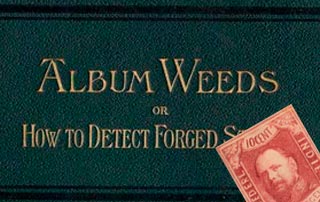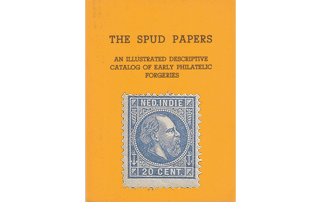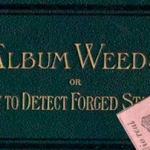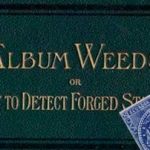Album Weeds – Netherlands Indies
 1864. 10 Cents, brownish-carmine.
1864. 10 Cents, brownish-carmine.
This stamp was first issued unperforated; but in 1865 it was machine-perforated 12 1/2 x 12. The type of both perforated and unperforated is exactly the same.
Genuine
Finely engraved in taille-douce, on soft, thin, yellowish- white wove paper, the face of which almost invariably shows a tinge of the same colour as the stamp, no doubt owing to the imperfect wiping of the plate during the process of printing. The same thing may be very well seen on some stamps of the United States, and on the 50 Reis, blue, of the first head issue of Brazil. The stamp is either unperforated, or machine-perforated 12 1/2 x 12, as above-mentioned; and the gum with which it is backed is of a dark, yellowish-brown colour, almost as dark as that on the first 3 cents of St. Thomas. The background, behind the head, is composed partly of crossed, vertical and horizontal lines, and partly of horizontal lines only; the portion of the background in the top, left-hand corner, has only horizontal lines. The king’s nose stands out well, with a blunt and rounded point. The front of the mustache is clipped rather short, so that the contour of both lips can be seen ; the upper lip is decidedly pointed in front. On the shoulder, above the L of ‘ZEGEL, will be seen a dim, white blotch, and one or two indistinct, white lines, forming the button and part of the shoulder-strap of the epaulette; but the whole would not be noticed, unless expressly looked for. The ground of the two side-labels, containing NEDERL INDIE, is very decidedly shaded with crossed, vertical and horizontal lines, which can be easily seen. The side-stroke of the 1 of 10 does not touch the tail of the left-hand dolphin; and the bottom of the said 1, and that of the T of CENT are both slightly pointed, instead of being cut off square. There are four lines of shading on the label, to the right of the T of CENT, and all four are of different lengths. This is very well marked.
Forged
Rather nicely lithographed, on white wove paper, very thin, not at all tinted, backed with white gum; unperforated. The whole of the background, behind the head, is shaded uniformly with crossed, vertical and horizontal lines. The king’s nose is much too white, and the point is quite sharp, compared with the genuine. The front of the mustache hides the upper lip altogether, and the outline of the mouth is one straight line. On the shoulder, above the L of ZEGEL, there is a very prominent and distinct mark, like a V on its side, with a large white dot or blotch inside it. The ground of the two side-labels, containing the words NEDERL INDIE, appears to be perfectly solid and uniform at first sight; though it is really formed by crossed lines, which are set so close that they have run together in almost every part. The side-stroke of the 1 of 10 touches the tail of the left-hand dolphin; and the bottoms of the 1, and of the T of CENT, are cut off almost square; indeed, that of the T is quite square. The four lines of shading, to the right of the T of CENT, are of equal height. The colour of this forgery is something like that of the genuine, but with more red and less brown in it. Mr. Pemberton calls the genuine stamp “rose”, but I never saw one that could be said even to approach that colour. One of my own specimens slightly resembles the normal tint of our own obsolete red 1d., and I suppose even that would hardly be called rose.
Postmarks
Genuine.—The genuine stamps bear 1, also 13.
Forged.—The forgeries have 1, also 72.
 1869. 5, 10, 20, 50 Cents. 1874-82. 15 Cents.
1869. 5, 10, 20, 50 Cents. 1874-82. 15 Cents.
Genuine
Engraved, in épargne, on thickish, white wove paper; no watermark. There are eighty-seven V pearls in the circle round the head. The lower lobe of the ear is very small, and part of it is shaded. The serpents, twining round the rods in the tops of the side-labels, have very distinct wings, each with four feathers. The bottoms of the anchors are both alike, both pointed, and their flukes are also all alike, and very distinctly barbed, like arrow-heads. The flukes or barbs are 5 separated from the arms of the anchors by little lines, which form the lower outlines of the barbs. The tails of the serpents do not touch the outline of the central circle. The pearls are very large, perfectly round, and all of exactly the same size. The letters of the inscriptions are very clear and broad, with their ends cut off perfectly square. There is a short, strong vertical line on the lower eyelid, below the front of the pupil.
First Forgery
Lithographed, rather carefully clone, on very white, and rather thick wove paper; unperforated, or pin-perf. 13. There are only eighty-six pearls round the central circle, and they are much smaller than those in the genuine, and irregular in shape; some of them being blotched together occasionally. The lower lobe of the ear is much larger than in the genuine, more prominent, and altogether without shading. The wings on the rods are not very distinctly drawn; they only show three feathers each, and the serpents below them have no eyes, though these can be distinctly seen in the genuine. The tail of one of the serpents, round the right-hand rod, almost touches the outline of the circle round the head, and in many copies it does touch it. The bottom of the left-hand anchor is more sharply pointed than the right-hand one, and the barbs are not all alike, one or more being generally a mere blotch. The letters of the inscriptions are too thin, blotchy or ragged, and their ends are all more or less rounded. There is a round dot on the lower eyelid, to represent the vertical line of the genuine.
Second Forgery
Not nearly so good as the one just described. Lithographed, on stout, very yellowish-white wove paper; pin-perf. 13. There are only sixty-seven pearls round the circle, and they are absurdly irregular in shape, most of them being like white hyphens. The lower lobe of the ear is shaded by two clots, instead of the fine lines of the genuine. The wings on the rods above the serpents’ heads are mere blotches, and the serpents do not appear to have any heads, much less mouth and eyes. The anchors are very sharply pointed at the bottom, but the barbs are only indistinct blotches. The right fluke of the left anchor splays out more than the corresponding one of the right anchor. The inscriptions are better than in the first forgery, though the rest of the impression is worse. There is a dot, or, sometimes, an oblique line of shading, on the lower eyelid, below the front of the pupil. I do not think this counterfeit likely to be at all dangerous.
Postmarks
Genuine.—1, 13 & 42
Forged.—A large circle with lettering. Also 13.
From: ‘Album Weeds’, 3rd edition by R. B. Eareé. 1906
 See also
See also





Leave a Reply
Want to join the discussion?Feel free to contribute!